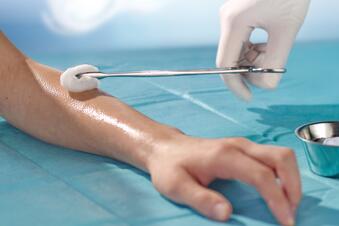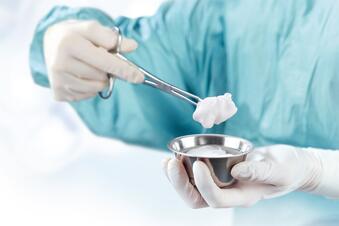
Infection prevention with a long-term effect
Our skin and mucous membrane antiseptics
Disinfecting the skin and mucous membranes before surgical procedures is one of the most elementary measures in infection prevention. Aqueous products such as our octenisept have always been established for disinfecting mucous membranes, while alcohol-based products are ideal for disinfecting the skin.

Skin disinfection
Skin antisepsis is one of the most important standards for the prevention of postoperative wound infections (SSI) and vascular catheter-associated bloodstream infections (CABSI). Preparations with a high alcohol content (≥ 60 %) are generally used for skin antisepsis, which enable a bacterial count reduction of 99 to 99.9 % with short exposure times.

Long-term effect and remanence of alcohol-based skin antiseptics
When testing for efficacy, preparations in Germany must not be inferior to the reference alcohol (70% 2-propanol) tested in parallel. In the DGHM test method from 1991, a long-term effect over 24 hours was required for the preparations in addition to the short-term effect. This long-term effect is based exclusively on the fact that bacterial growth is delayed after the alcohol content in the test or reference preparation has initially greatly reduced the bacterial count.
Our products kodan® tincture forte colored and kodan® tincture forte colorless naturally meet this requirement. Thus, kodan® tincture forte did not differ significantly from the reference alcohol in its efficacy against the resident skin flora on skin with few sebaceous glands [1]. Accordingly, kodan® Tinktur forte shows by definition a long-term effect over 24 hours.
The current DGHM test methods from 2002 no longer provide evidence of such a long-term effect over 24 hours. The residual effect must be clearly distinguished from this long-term effect. This effect is achieved by active ingredients such as octenidine dihydrochloride (octenidine) or chlorhexidine. After the alcohol has dried off, these active ingredients remain on the skin for a longer period of time and continue to exert their antimicrobial properties against resident and transient flora during this time. After the alcohol has dried, the bacterial count is further reduced over time. Although the remanence effect cannot be demonstrated by standardized test methods, it can be clearly demonstrated experimentally and clinically.

Octenidine for the prevention of vascular catheter-associated infections
The use of products with a remanent effect is particularly recommended for surgical procedures that take a long time and where there is a high risk of infection. Infections associated with (vascular) catheters or other accesses can lead to sepsis or septic shock in severe cases. Intensive care patients are particularly at risk here. In order to sustainably reduce the skin flora around the catheter entry site, the use of an alcoholic skin antiseptic in combination with a remanent active ingredient such as octenidine - e.g. octeniderm® colorless - is therefore recommended for skin disinfection before inserting a vascular catheter.
With its remanence of 48 hours, octeniderm® colorless is more effective in clinical comparisons than purely alcohol-based preparations or preparations based on alcohol and benzalkonium chloride. The sustained reduction of germs with octeniderm® colorless reduces the risk of catheter-associated infections.
Our products

kodan® tincture forte coloured
Ready-to-use coloured skin antiseptic with a long-term effect of at least 24 hours
kodan® tincture forte colourless
Ready-to-use skin antiseptic with a long-term effect of at least 24 hours
wall bracket for mikrozid®/kodan®
Universal wall holder for kodan® wipes and mikrozid® AF wipes
octeniderm® colourless
Colourless skin antiseptic with residual antimicrobial activity of at least 48 hours
kodan® tincture forte coloured
Active substances: 2-propanol (Ph. Eur.), 1-propanol (Ph. Eur.), biphenyl-2-ol. Composition: 100 g solution contain 45.0 g 2-propanol (Ph. Eur.), 10.0 g 1-propanol (Ph. Eur.), 0.20 g biphenyl-2-ol. Other ingredients: quinoline yellow, orange yellow S., brilliant black PN, hydrogen peroxide solution 30% (Ph. Eur.), purified water. Indications: Skin disinfection prior to surgical procedures, catheterization, blood and liquor collection, injections, punctures, excisions, cannulations, biopsies, for antiseptic care of sutures as well as for additional general hygienic measures to prevent fungal skin infections. Contraindications: kodan® tincture forte coloured may not be used in cases of hypersensitivity to any of the components of the preparation. Undesirable effects: Particularly with frequent use, skin irritations such as burning, erythema and dryness can occur. In rare cases allergic contact reactions are possible. Revision 04/20
If any of the side effects get serious, or if you notice any side effects not listed in this user information, please tell your doctor or pharmacist.
Schülke & Mayr GmbH, 22840 Norderstedt, Germany, Tel. +49 40 52100-666, info@schuelke.com
kodan® tincture forte colourless
Active substances: 2-propanol (Ph. Eur.), 1-propanol (Ph. Eur.), biphenyl-2-ol. Composition: 100 g solution contain 45.0 g 2-propanol (Ph. Eur.), 10.0 g 1-propanol (Ph. Eur.), 0.20 g biphenyl-2-ol. Other ingredients: hydrogen peroxide solution 30% (Ph. Eur.), purified water. Indications: Skin disinfection prior to surgical procedures, catheterization, blood and liquor collection, injections, punctures, excisions, cannulations, biopsies, for antiseptic care of sutures as well as for additional general hygienic measures to prevent fungal skin infections. If no special hand disinfectant is available kodan® tincture forte colourless may also be used for hygienic hand disinfection. Contraindications: kodan® tincture forte colourless should not be used for surgical hand disinfection. kodan® tincture forte colourless may not be used in cases of hypersensitivity to any of the components of the preparation. Undesirable effects: Particularly with frequent use, skin irritations such as burning, erythema and dryness can occur. In rare cases allergic contact reactions are possible. Revision 01/22If any of the side effects gets serious, or if you notice any side effects not listed in this user information, please tell your doctor or pharmacist.
Schülke & Mayr GmbH, 22840 Norderstedt, Germany, Tel. +49 40 52100-666, info@schuelke.com
octeniderm® colourless
Active substances: octenidine dihydrochloride, 1-propanol (Ph.Eur.), 2-propanol (Ph.Eur.). Composition: 100 g solution contain: 0.1 g octenidine dihydrochloride, 30.0 g 1-propanol (Ph.Eur.), 45.0g 2-propanol (Ph.Eur.). Other ingredients: purified water. Indications: Skin disinfection prior to surgical procedures, catheterization, blood and liquor collection, injections, punctures, excisions, cannulations, biopsies and for antiseptic care of sutures. If no special hand disinfectant is available, octeniderm® colourless can also be used for hygienic and surgical hand disinfection. Contraindications: octeniderm® colourless should not be used in case of hypersensitivity to any of the components of the preparation. Undesirable effects: Particularly in cases of frequent use, skin irritation such as redness, burning and itching may occasionally occur. In rare cases allergic reactions (e.g. contact eczema) are possible. Revision 01/22
If any of the side effects gets serious, or if you notice any side effects not listed in this user information, please tell your doctor or pharmacist.
Schülke & Mayr GmbH, 22840 Norderstedt, Germany, Tel. +49 40 52100-666, info@schuelke.com
Data protection notice
We use analysis methods (e.g. cookies) to measure how often our website is visited and how it is used. We also use cookies to link your page visits and website usage with your customer data stored in our CRM system in order to be able to address you individually, i.e. based on your interests and usage. We alsowe embed third-party content from other providers (e.g. videos). We have no influence on further data processing and any tracking by the third-party provider.In this context, we also use service providers in third countries outside the EU that may not guarantee an adequate level of data protection, which entails the following risks Access by authorities without informing the data subject, no data subject rights, no legal remedies, loss of control.By hiring us, you consent to the processes described above. You can revoke your consent with effect for the future. You can find more information in our privacy policy






















